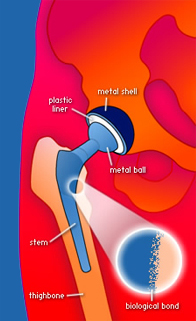Total Hip Replacement

Total hip replacement surgery is indicated, when pain and mobility limitations caused by osteoarthritis, aseptic necrosis and other hip diseases cannot be adequately controlled by other, “simpler” methods.
During the operation, two parts of the hip joint - the top of the thighbone (femoral head) and the hip socket (acetabulum) - are removed and replaced with artificial elements made of high-density plastic and a stainless metal (typically an alloy containing titanium). These implants, called prosthesis, are held in place by tight fit (initially) and later biologic bond, which forms between the bone and the implant’s porous surface. Alternative method uses special bone cement to hold the implant in place. Generally speaking the “non-cemented” implants are the most common type in North America, whereas the “cemented” option is more common in Europe. The judgment regarding the superiority of one method over the other is still not settled. In my opinion, it is the surgical skill that will determine the outcome more than the implant type. I use the non-cemented implants.
